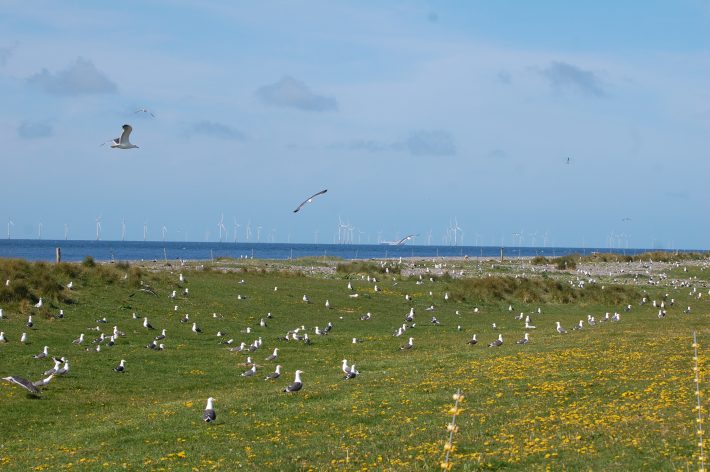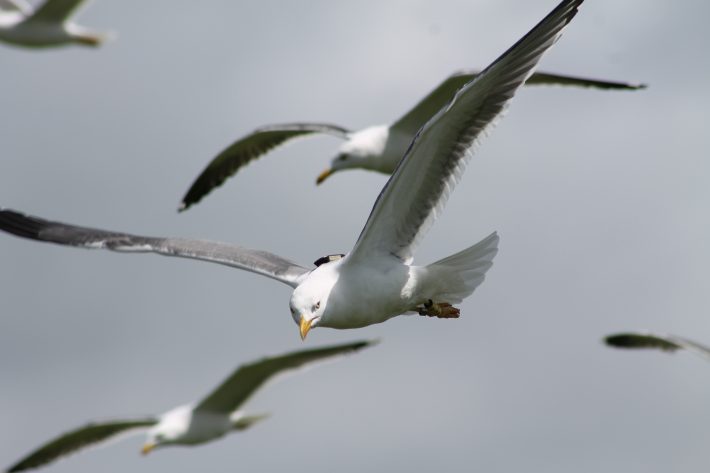Wildlife and wind farms: Are British gulls staying safe in the winter sun?
British Trust for Ornithology press release.
New research by the British Trust for Ornithology (BTO), published today in the Journal of Applied Ecology, shows that Lesser Black-backed Gulls breeding in Britain could be vulnerable to collisions with wind turbines whilst on migration and during the winter months as well as during the breeding season.

There are now estimated to be more than 341,000 wind turbines installed and spinning on the planet as part of global initiatives to tackle carbon emissions. It is important to understand how these structures might affect wildlife. In this study, BTO researchers fitted state-of-the art GPS tags to Lesser Black-backed Gulls breeding at three major UK colonies in order to track their movements throughout the year.
By combining the data from the tags with information on wind turbine locations they were able to establish how vulnerable this species might be to collisions. The GPS devices recorded how fast and how high birds fly, as well as the time birds spent in particular areas. This information was used to estimate the risk of birds colliding with wind turbines when flying at altitudes swept by the turbines’ blades.
The results showed that Lesser Black-backed Gulls are vulnerable during the breeding season, when birds are tied to feeding areas close to their colonies, many of which are also in the vicinity of wind farms. Furthermore, the scientists also found the birds to be at risk once the breeding season is over and they disperse south to Spain, Portugal and north Africa where they overwinter.
Dr Chris Thaxter, Senior Research Ecologist at the BTO and the paper’s lead author, said “We knew that Lesser Black-backed Gulls were at risk of colliding with wind turbines, but what we didn’t know was where and when birds from specific breeding colonies may be most vulnerable across their annual life cycle. The fact that we have been able to answer some of these questions is testimony to the advances in tracking technology we have seen in recent years. Mapping vulnerability to collision risk in this way can also help identify where may be best to site new wind farms in the future to minimise any harm to wildlife.”

Dr Viola Ross-Smith, co-author on the paper and Science Communications Manager at the BTO, said “We were surprised to see how vulnerable Lesser Black-backed Gulls could be to collision at some of their wintering destinations, such as Lisbon and Malaga, as well as when they were on migration. Galicia in northern Spain stood out as a spot where birds were vulnerable. This region contains a high density of wind turbines and is an important stopping over site for Lesser Black-backed Gulls, as well as for many other migratory bird species.”
The UK is a global stronghold for breeding Lesser Black-backed Gulls. Although this species can be unpopular with Brits during the summer months due to the proclivity of some individuals to steal chips and nest on rooftops, it is Amber-listed in the UK’s Birds of Conservation Concern and is protected by law. Studies like this show how important it is to consider factors across an animal’s annual cycle, at home and abroad, in protecting and conserving birds and other species.
Read full study:
Thaxter CB, Ross‐Smith VH, Bouten W, et al. Avian vulnerability to wind farm collision through the year: Insights from lesser black‐backed gulls (Larus fuscus) tracked from multiple breeding colonies. J Appl Ecol. 2019;00:1–13. https://doi.org/10.1111/1365-2664.13488
Media contacts:
Dr Viola Ross-Smith, co-author and Science Communications Manager
Email: viola.ross-smith@bto.org
Like what we stand for?
Support our mission and help develop the next generation of ecologists by donating to the British Ecological Society.